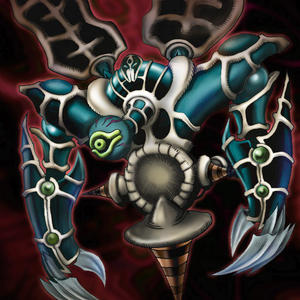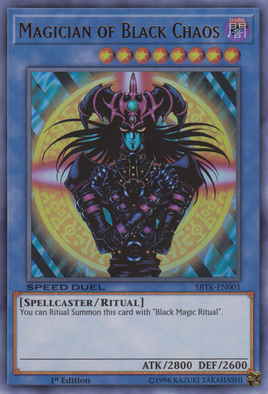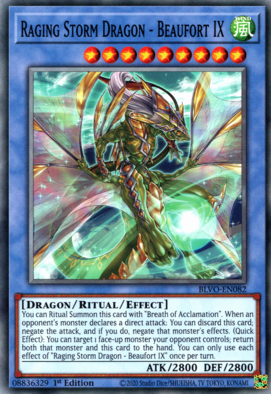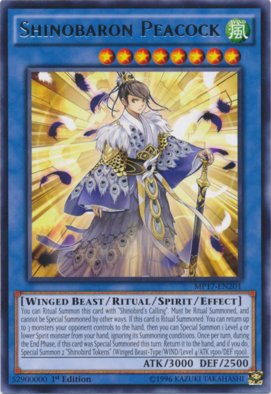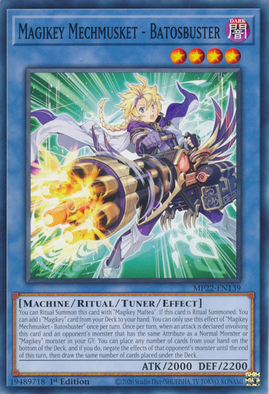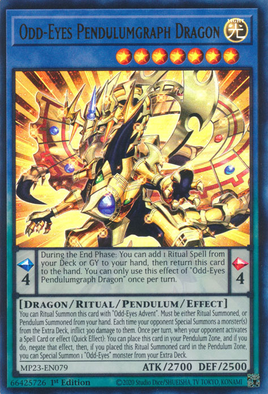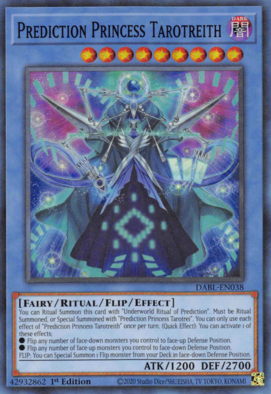Difference between revisions of "Ritual Monster"
(→Trivia: minor edit to the Relinquish color point) (Tag: New user edit) |
|||
| (74 intermediate revisions by 37 users not shown) | |||
| Line 1: | Line 1: | ||
{{Infobox/Archetype/Start | {{Infobox/Archetype/Start | ||
| − | + | | image name = Relinquished-TF05-JP-VG-artwork.png | |
| − | + | | image caption = "[[Relinquished]]" | |
| − | |||
}} | }} | ||
{{Infobox/Archetype/ExtendedName | {{Infobox/Archetype/ExtendedName | ||
| − | + | | kanji = {{Ruby|儀|ぎ}}{{Ruby|式|しき}}(モンスター)<ref group=Notes>The parentheses here specify what part is not shown on the cards' [[Type]]/[[Ability]] line.</ref> | |
| − | + | | japanese = 儀式(モンスター) | |
| − | |japanese=儀式(モンスター) | + | | furigana = ぎしき(モンスター) |
| − | |furigana=ぎしき(モンスター) | + | | romaji = Gishiki (Monsutā) |
| − | + | | japanese translated = | |
| − | + | | english = Ritual (Monster) | |
| − | + | | french = (Monstre) Rituel | |
| − | + | | german = Ritual(monster) | |
| − | + | | italian = (Mostro) Rituale | |
| − | + | | korean = 의식 (몬스터) (儀式 (Monster)) ''Uisik (Monseuteo)'' | |
| − | + | | portuguese = (Monstro de) Ritual | |
| − | + | | spanish = (Monstruo de) Ritual | |
| − | + | | chinese = 儀式怪獸 ''Yíshì Guàishòu / Ji4 sik1 (Gwaai3 sau3)'' | |
| − | |chinese=儀式怪獸 ''Yíshì Guàishòu / Ji4 sik1 (Gwaai3 sau3)'' | + | |simplified chinese=仪式怪兽 ''Yíshì Guàishòu'' |
}} | }} | ||
{{Infobox/Archetype/Yu-Gi-Oh! | {{Infobox/Archetype/Yu-Gi-Oh! | ||
| − | + | | list = List of Ritual Monsters | |
| − | + | | support list = List of Ritual Monster support cards | |
| − | + | | anti-support list = List of Ritual Monster anti-support cards | |
}} | }} | ||
{{Infobox/Archetype/End}} | {{Infobox/Archetype/End}} | ||
| − | '''Ritual Monsters''' (Japanese: {{Ruby|儀|ぎ}}{{Ruby|式|しき}}モンスター ''Gishiki Monsutā'') | + | '''Ritual Monsters''' (Japanese: {{Ruby|儀|ぎ}}{{Ruby|式|しき}}モンスター ''Gishiki Monsutā'') are a [[Monster card type|type]] of [[monster]]s that must be [[Ritual Summon]]ed. Their card frame is colored in blue. |
| − | Ritual Monsters are [[Special Summon | + | ==Characteristics== |
| + | Ritual Monsters are stored in the [[Main Deck]]. They are [[Special Summon Monster]]s; they cannot be [[Normal Summon]]ed or [[Set]], cannot be [[Special Summon]]ed with [[Pendulum Summon]]ing, and cannot be Special Summoned from the [[hand]] or [[Deck]] by non-Ritual Summoning [[effect|card effects]], unless: | ||
| − | + | * The effect specifically states that it Special Summons Ritual Monsters (e.g. "[[Ritual Foregone]]"), and the Ritual Monster being Summoned does not have a "Must be Ritual Summoned" condition, OR, | |
| − | + | * The effect [[Ignoring the Summoning conditions|Ignores the monster's Summoning conditions]]. | |
| − | + | If a Ritual Monster is not properly [[Ritual Summon]]ed before being sent to the [[Graveyard]] or banished, it cannot be [[Special Summon]]ed from there by non-Ritual Summoning card effects.<ref>{{cite web |url=http://www.db.yugioh-card.com/yugiohdb/faq_search.action?ope=5&fid=14410&request_locale=ja |date=20 November 2014 |title=Q&A » 手札やデッキから墓地へ送られた「トリシューラの影霊衣」を、「影霊衣の反魂術」によって墓地から特殊召喚できますか? |publisher=Konami |language=Japanese |trans-title=Q&A » If "Nekroz of Trishula" is sent from the hand or Deck to the Graveyard, can it be Special Summoned from the Graveyard by "Nekroz Cycle"? |accessdate=3 April 2016}}</ref><ref>{{cite web |url=http://entertainment.upperdeck.com/yugioh/en/gameplay/faqs/cardfaqs/default.aspx?first=D&last=E |title=Individual Card Rulings [D-E] |publisher=UDE |at=Dimension Fusion |accessdate=12 December 2015 |archiveurl=http://web.archive.org/web/20090218205242/http://entertainment.upperdeck.com/yugioh/en/gameplay/faqs/cardfaqs/default.aspx?first=D&last=E |archivedate=18 February 2009}}</ref><ref>{{cite web |url=http://entertainment.upperdeck.com/yugioh/en/gameplay/faqs/cardfaqs/default.aspx?first=A&last=C |title=Individual Card Rulings [A-C] |publisher=UDE |at=Contract with the Abyss |accessdate=12 December 2015 |archiveurl=http://web.archive.org/web/20090217182013/http://entertainment.upperdeck.com/yugioh/en/gameplay/faqs/cardfaqs/default.aspx?first=A&last=C |archivedate=17 February 2009}}</ref><ref>{{cite web |url=http://entertainment.upperdeck.com/yugioh/en/gameplay/faqs/cardfaqs/default.aspx?first=F&last=H |title=Individual Card Rulings [F-H] |publisher=UDE |at=Fulfillment of the Contract |accessdate=12 December 2015 |archiveurl=http://web.archive.org/web/20090226221414/http://entertainment.upperdeck.com/yugioh/en/gameplay/faqs/cardfaqs/default.aspx?first=F&last=H |archivedate=26 February 2009}}</ref><ref>{{cite book |last=Konami |title=Yu-Gi-Oh! Trading Card Game - Official Rulebook Version 6.0 |url=https://yugipedia.com/wiki/File:Rulebook_v6.0.pdf?page=10 |page=15}}</ref> | |
| − | + | A properly Special Summoned Ritual Monster loses its status if it is returned to the [[hand]] or [[Main Deck|Deck]].<ref>{{cite web |url=http://entertainment.upperdeck.com/community/forums/thread/853512.aspx |title=Ritual/Fusion Monsters vs. Legal Revival Target |date=18 September 2007 |archiveurl=http://web.archive.org/web/20071102200622/http:/entertainment.upperdeck.com/community/forums/thread/853512.aspx |archivedate=2 November 2007 |accessdate=12 December 2015}}</ref><ref>{{cite book |last=Konami |title=Yu-Gi-Oh! Trading Card Game - Official Rulebook Version 5.0 |url=https://yugipedia.com/wiki/File:Rulebook_v5.0.pdf?page=17 |page=13}}</ref> | |
| − | == | + | ===Ritual Summoning condition=== |
| − | Ritual Summoning is | + | {{Main|Ritual Summoning condition}} |
| + | Every Ritual Monster mentions one or more cards that can Ritual Summon the Ritual Monster in the first line of its [[card text]]. The card(s) mentioned is typically a [[Ritual Spell]], but can also be non-Ritual Spell cards, primarily for the Ritual archetypes that lack a Ritual Spell (e.g. "[[Megalith]]", "[[Libromancer]]"). | ||
| − | + | The mentioned card(s) is never the ''only'' card(s) that can Ritual Summon the Ritual Monster, but rather one that ''can'' be used for its Ritual Summon. All Ritual Monsters can be Ritual Summoned using effects of other appropriate Ritual Summoning cards, even if they are not mentioned on the Ritual Monster card. | |
| − | + | ===Ritual Summoning=== | |
| + | {{main|Ritual Summon}} | ||
| − | Ritual | + | Ritual Monsters must first be Special Summoned by [[Ritual Summon]]ing, using the effect of a card that performs a Ritual Summon. |
| − | == | + | Usually, Ritual Summoning is performed by a [[Ritual Spell Card]], with an effect that involves tributing monsters from the player's hand or field whose levels equal or exceed the Ritual Monster being Ritual Summoned, then Ritual Summoning the Ritual Monster from the player's hand. |
| − | [[ | + | |
| + | ==In the anime== | ||
| + | Ritual Monsters have not featured as a major mechanic in the anime. | ||
| + | |||
| + | ===Yu-Gi-Oh! (anime)=== | ||
| + | In ''[[Yu-Gi-Oh! (anime)|Yu-Gi-Oh]]'', some prominent characters used Ritual Monsters, including [[Yugi Muto]], [[Joey Wheeler]], [[Seto Kaiba]], [[Maximillion Pegasus]], [[Dartz]], and the [[Rare Hunter]]s [[Umbra]] and [[Lumis]]. | ||
| + | |||
| + | ===Yu-Gi-Oh! GX=== | ||
| + | In ''[[Yu-Gi-Oh! GX]]'', Ritual Monsters occasionally appeared; Fusion Monsters were more prominently associated with the series. [[Alexis Rhodes]] used the first Ritual Monster-focused archetype; "[[Cyber Angel]]". [[Bastion Misawa]], [[Titan]], and [[Kaibaman (character)|Kaibaman]] all used a Ritual Monster. | ||
| + | |||
| + | ===Yu-Gi-Oh! ZEXAL=== | ||
| + | In ''[[Yu-Gi-Oh! ZEXAL]]'', a single Ritual Monster appeared, used by [[Kite Tenjo]]. | ||
| + | |||
| + | ===Yu-Gi-Oh! ARC-V=== | ||
| + | In ''[[Yu-Gi-Oh! ARC-V]]'', Ritual Monsters were used by two characters, [[Alexis Rhodes (ARC-V)|Alexis Rhodes]] and [[Aura Sentia]], neither of whom were featured significantly. | ||
| + | |||
| + | ===Yu-Gi-Oh! VRAINS=== | ||
| + | In ''[[Yu-Gi-Oh! VRAINS]]'', Ritual Summoning was the first non-Link Summon Special Summon method reintroduced in the series. [[Yusaku Fujiki]] and [[Theodore Hamilton]] used one Ritual Monster each, and [[Ai]] later used one of his own. | ||
| + | |||
| + | ==Examples== | ||
| + | {{Show card image gallery | ||
| + | | Magician of Black Chaos | Non-Effect Ritual Monster | ||
| + | | Raging Storm Dragon - Beaufort IX | Effect Ritual Monster | ||
| + | | Shinobaron Peacock | Spirit Ritual Monster | ||
| + | | Magikey Mechmusket - Batosbuster | Tuner Ritual Monster | ||
| + | | Odd-Eyes Pendulumgraph Dragon | Pendulum Ritual Monster | ||
| + | | Prediction Princess Tarotreith | Ritual Flip Monster | ||
| + | }} | ||
==Trivia== | ==Trivia== | ||
| − | * | + | * Ritual Monsters have the fewest number of anti-support cards of all monster [[card type]]s, with only {{hardcoded query|{{#ask: [[Concept:CG cards]] [[Anti-support::Ritual Monster]] |format=count}}}} cards specifically designed to stop them: "{{hardcoded query|{{#ask: [[Concept:CG cards]] [[Anti-support::Ritual Monster]] |format=list |sep=", "}}}}". |
| − | * | + | * "[[Magikey Mechmusket - Batosbuster]]" is the only [[Tuner]] Ritual Monster. |
| − | * | + | * "[[Prediction Princess Tarotreith]]" is the only [[Flip Monster|Flip]] Ritual Monster. |
| − | * Ritual Monsters | + | * "[[Odd-Eyes Pendulumgraph Dragon]]" is the only [[Pendulum Monster|Pendulum]] Ritual Monster. |
| + | |||
| + | * "[[Drytron Meteonis Alpha Draconids]]" has the highest ATK and DEF of all Ritual monsters. | ||
| + | |||
| + | * In the early days of the game, Ritual Monsters were seemingly meant to be counterparts of [[Fusion Monsters]]: | ||
| + | ** Ritual Monsters needed a Spell specific to each of them. Fusions had a generic Spell they all could use. | ||
| + | ** Rituals needed to be searched for in the Deck. Fusions were easily accessible in the Extra Deck. | ||
| + | ** Rituals could use any monsters, and could use a single monster if the Level was equal or greater than their own. Fusions needed specific monsters, and a minimum of two. | ||
| + | |||
| + | * The blue color scheme for Ritual Monsters in the card game may have been inspired by "[[Relinquished]]", the first Ritual Effect Monster. | ||
| + | |||
| + | * [[Yugi Muto]] and [[Yusaku Fujiki]] are the only protagonists to use Ritual Monsters. | ||
| + | |||
| + | * [[Seto Kaiba]] and [[Kite Tenjo]] are the only rivals to use Ritual Monsters. | ||
| + | |||
| + | * [[Alexis Rhodes]] is the only heroine to use Ritual Monsters. | ||
==Notes== | ==Notes== | ||
<references group=Notes/> | <references group=Notes/> | ||
| − | {{ | + | ==References== |
| + | <references/> | ||
| + | |||
| + | {{Card types}} | ||
[[Category:Types of Monster Cards]] | [[Category:Types of Monster Cards]] | ||
Revision as of 16:24, 8 May 2024
| Ritual Monster | |||
|---|---|---|---|
|
| |||
| Japanese |
| ||
| Japanese (ruby) |
ぎしき(モンスター) | ||
| Japanese (base text) |
儀式(モンスター) | ||
| Japanese (romanized) |
Gishiki (Monsutā) | ||
| English |
Ritual (Monster) | ||
| |||
| Lists |
| ||
Ritual Monsters (Japanese:
Contents
Characteristics
Ritual Monsters are stored in the Main Deck. They are Special Summon Monsters; they cannot be Normal Summoned or Set, cannot be Special Summoned with Pendulum Summoning, and cannot be Special Summoned from the hand or Deck by non-Ritual Summoning card effects, unless:
- The effect specifically states that it Special Summons Ritual Monsters (e.g. "Ritual Foregone"), and the Ritual Monster being Summoned does not have a "Must be Ritual Summoned" condition, OR,
- The effect Ignores the monster's Summoning conditions.
If a Ritual Monster is not properly Ritual Summoned before being sent to the Graveyard or banished, it cannot be Special Summoned from there by non-Ritual Summoning card effects.[1][2][3][4][5]
A properly Special Summoned Ritual Monster loses its status if it is returned to the hand or Deck.[6][7]
Ritual Summoning condition
Every Ritual Monster mentions one or more cards that can Ritual Summon the Ritual Monster in the first line of its card text. The card(s) mentioned is typically a Ritual Spell, but can also be non-Ritual Spell cards, primarily for the Ritual archetypes that lack a Ritual Spell (e.g. "Megalith", "Libromancer").
The mentioned card(s) is never the only card(s) that can Ritual Summon the Ritual Monster, but rather one that can be used for its Ritual Summon. All Ritual Monsters can be Ritual Summoned using effects of other appropriate Ritual Summoning cards, even if they are not mentioned on the Ritual Monster card.
Ritual Summoning
Ritual Monsters must first be Special Summoned by Ritual Summoning, using the effect of a card that performs a Ritual Summon.
Usually, Ritual Summoning is performed by a Ritual Spell Card, with an effect that involves tributing monsters from the player's hand or field whose levels equal or exceed the Ritual Monster being Ritual Summoned, then Ritual Summoning the Ritual Monster from the player's hand.
In the anime
Ritual Monsters have not featured as a major mechanic in the anime.
Yu-Gi-Oh! (anime)
In Yu-Gi-Oh, some prominent characters used Ritual Monsters, including Yugi Muto, Joey Wheeler, Seto Kaiba, Maximillion Pegasus, Dartz, and the Rare Hunters Umbra and Lumis.
Yu-Gi-Oh! GX
In Yu-Gi-Oh! GX, Ritual Monsters occasionally appeared; Fusion Monsters were more prominently associated with the series. Alexis Rhodes used the first Ritual Monster-focused archetype; "Cyber Angel". Bastion Misawa, Titan, and Kaibaman all used a Ritual Monster.
Yu-Gi-Oh! ZEXAL
In Yu-Gi-Oh! ZEXAL, a single Ritual Monster appeared, used by Kite Tenjo.
Yu-Gi-Oh! ARC-V
In Yu-Gi-Oh! ARC-V, Ritual Monsters were used by two characters, Alexis Rhodes and Aura Sentia, neither of whom were featured significantly.
Yu-Gi-Oh! VRAINS
In Yu-Gi-Oh! VRAINS, Ritual Summoning was the first non-Link Summon Special Summon method reintroduced in the series. Yusaku Fujiki and Theodore Hamilton used one Ritual Monster each, and Ai later used one of his own.
Examples
Non-Effect Ritual Monster ("Magician of Black Chaos")
Effect Ritual Monster ("Raging Storm Dragon - Beaufort IX")
Spirit Ritual Monster ("Shinobaron Peacock")
Tuner Ritual Monster ("Magikey Mechmusket - Batosbuster")
Pendulum Ritual Monster ("Odd-Eyes Pendulumgraph Dragon")
Ritual Flip Monster ("Prediction Princess Tarotreith")
Trivia
- Ritual Monsters have the fewest number of anti-support cards of all monster card types, with only 16 cards specifically designed to stop them: "Brutal Beast Battle", "The Bystial Alba Los", "Bystial Baldrake", "Dimensional Barrier", "Heritage of the Light", "Inspector Boarder", "Invincibility Barrier", "Masquerade the Blazing Dragon", "Mikanko Spiritwalk", "New Frontier", "Ritual Buster", "Ritual Sealing", "Simul Archfiends", "Sophia, Goddess of Rebirth", "Steelswarm Sting", "Swordsoul Punishment".
- "Magikey Mechmusket - Batosbuster" is the only Tuner Ritual Monster.
- "Prediction Princess Tarotreith" is the only Flip Ritual Monster.
- "Odd-Eyes Pendulumgraph Dragon" is the only Pendulum Ritual Monster.
- "Drytron Meteonis Alpha Draconids" has the highest ATK and DEF of all Ritual monsters.
- In the early days of the game, Ritual Monsters were seemingly meant to be counterparts of Fusion Monsters:
- Ritual Monsters needed a Spell specific to each of them. Fusions had a generic Spell they all could use.
- Rituals needed to be searched for in the Deck. Fusions were easily accessible in the Extra Deck.
- Rituals could use any monsters, and could use a single monster if the Level was equal or greater than their own. Fusions needed specific monsters, and a minimum of two.
- The blue color scheme for Ritual Monsters in the card game may have been inspired by "Relinquished", the first Ritual Effect Monster.
- Yugi Muto and Yusaku Fujiki are the only protagonists to use Ritual Monsters.
- Seto Kaiba and Kite Tenjo are the only rivals to use Ritual Monsters.
- Alexis Rhodes is the only heroine to use Ritual Monsters.
Notes
References
- ↑ "Q&A » 手札やデッキから墓地へ送られた「トリシューラの影霊衣」を、「影霊衣の反魂術」によって墓地から特殊召喚できますか?" [Q&A » If "Nekroz of Trishula" is sent from the hand or Deck to the Graveyard, can it be Special Summoned from the Graveyard by "Nekroz Cycle"?] (in Japanese). Konami. 20 November 2014. Retrieved 3 April 2016.
- ↑ "Individual Card Rulings [D-E]". UDE. Dimension Fusion. Archived from the original on 18 February 2009. Retrieved 12 December 2015.
- ↑ "Individual Card Rulings [A-C]". UDE. Contract with the Abyss. Archived from the original on 17 February 2009. Retrieved 12 December 2015.
- ↑ "Individual Card Rulings [F-H]". UDE. Fulfillment of the Contract. Archived from the original on 26 February 2009. Retrieved 12 December 2015.
- ↑ Konami. Yu-Gi-Oh! Trading Card Game - Official Rulebook Version 6.0 (PDF). p. 15.
- ↑ "Ritual/Fusion Monsters vs. Legal Revival Target". 18 September 2007. Archived from the original on 2 November 2007. Retrieved 12 December 2015.
- ↑ Konami. Yu-Gi-Oh! Trading Card Game - Official Rulebook Version 5.0 (PDF). p. 13.
